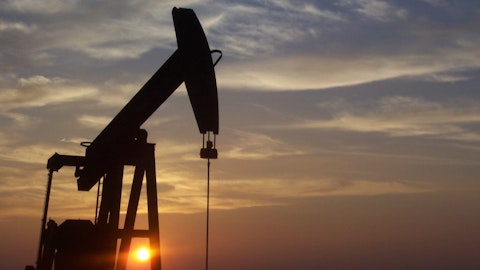Just a few more points in terms of production growth. For our onshore offshore business, rather, we have some new volumes coming online from Samurai V, which we expect in the second quarter, Dalmatian DC 90 well in the second half of the year, and of course, TERANOVA, which you highlighted. So if you think about rough production rates, Samurai 5 is in the 3,000 to 4,000 net BOE range when it comes online around 5,000 barrels per day and TERANOVO should get to about 6,000 barrels per day net to us when it comes online. And that’s really how we come up with our offshore forecast. As Roger highlighted, for onshore, with our new volumes, we have quite a bit of growth of Tupper Montney volume from first to fourth quarter with our wells coming online through the year and being fully online in the third quarter.
We ought to see a pretty substantial increase there, and that’s how we — to model our business.
Roger Jenkins: Further to that, I think there was a question you had room and I appreciate these questions because we really have a big growth year. We’re proud of our oil growth and ever-increasing oil production. Same Malo’s a great field, one of the best probably margin fuels in the world. We’re very fortunate to be an owner that it’s a solid 10,000, 11,000, 12,000 barrels a day business. The waterflood project does come and go with CapEx. We’re working with a super major here who changes the phasing of the CapEx on occasion. But this is going to be really about stopping decline and maintaining pressure in the reservoir as we start injecting this in about a year, and there’ll be an inflection from that to add significant reserves there for us.
So that project continues to go well. But they face CapEx in and out on the year on occasion as they execute it, and there’s a production well that’s coming on at the end of this year and also the injector wells are being completed. So Chevron continues to progress that, have a great relationship with them and moving that forward. It’s a very nice asset for us.
Arun Jayaram: Great. And just my follow-up, Roger, is on Murphy 2.0. I think you mentioned you’re soon to reach that $1.8 billion threshold. So how should we think about kind of cash returns in ’23? I mean I was thinking out loud is it just basically we take your free cash flow forecast and multiplied by $0.25, and that will be the cash return to the higher dividend and buybacks. Is that the way to think about it this year?
Roger Jenkins: Arun, thanks for that, and I’m proud of that framework. That’s not iWork. We have adjusted free cash flow that we described in the slide, and we would be removing from our — so we take the CapEx or take the operating cash flow less the capital spending on the cash flow statement, then you have to remove dividends and where we have to pay contingent payments, you remember the focus on contingent payments last year. So we’d be removing our NCI payments, our quarterly dividend and our — not NCI, our distributions to pension, abandonments, quarterly dividends and things of that nature, we get to adjusted free cash flow. This is outlined on Slide 26. This year, we probably have 200 and something, the high 200s of abandonment and contingent payments are the biggest factors in that.





